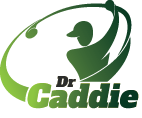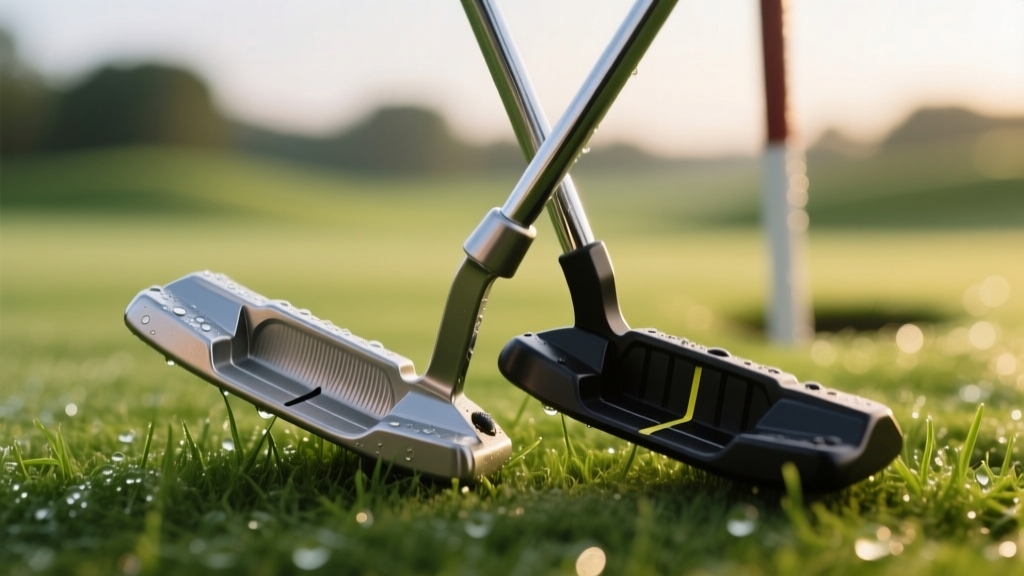When choosing between blade and mallet putters, consider their design and performance differences. Blades offer compact, heel-toe weighted construction, lower MOI, and excel for precision with arced strokes but provide less forgiveness.
Mallets feature larger heads, perimeter weighting, higher MOI, and enhanced stability, ideal for straight strokes and improved mis-hit resistance. Blades deliver better feel and mid-to-long distance control; mallets boost short-range consistency.
Understanding these nuances helps match your stroke style and putting needs perfectly.
- Notched Groove Design for Enhanced Precision: Featuring a notched strike surface design with precise…
- Perfect Weight and Length for All Golfers: This 34-inch golf putter is designed with a balanced…
- High Forgiveness for Improved Accuracy: Designed with high fault tolerance, this putter helps…
- HIGH MOI DESIGN – For added forgiveness
- PLUMBER’S NECK HOSEL – Offset hosel to ensure hands ahead of the putter
- SOFT TPU FACE INSERT – For added feel at impact
- Key Takeaways
- Design and Construction Differences
- Weight Distribution and Moment of Inertia
- Forgiveness and Playability Comparison
- Compatibility With Different Stroke Types
- Distance Performance and Player Preferences
- Frequently Asked Questions
- How Does Putter Choice Affect Green Reading and Reading Breaks?
- Are There Differences in Maintenance Between Blade and Mallet Putters?
- What Impact Does Putter Shaft Length Have on Blade Vs Mallet Performance?
- Can Blade or Mallet Putters Be More Effective on Different Green Speeds?
- How Do Blade and Mallet Putters Differ in Terms of Resale Value?
- Elevate Your Putting Game with the Right Choice
Key Takeaways
- Mallet putters have larger heads with higher MOI, offering greater forgiveness and stability on off-center hits compared to blade putters.
- Blade putters feature a compact, solid design that provides enhanced feedback and are preferred for precise, arced putting strokes.
- Mallet putters suit straight-back, straight-through strokes with bold alignment aids, while blades favor natural arc strokes with minimal alignment cues.
- Blades excel at mid-to-long distance putting with better lag control, whereas mallets perform best in short-range, reducing three-putts effectively.
- Recreational golfers often choose mallets for consistency, while tour pros typically prefer mallets or mid-mallets for stroke stability and forgiveness.
Design and Construction Differences
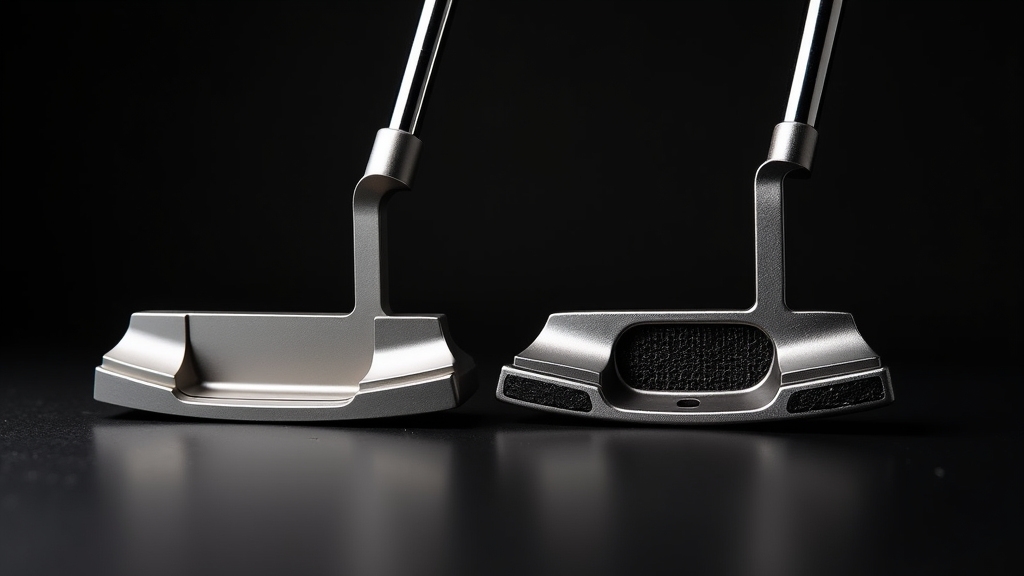
Although both blade and mallet putters serve the same fundamental purpose, their design and construction differ considerably, impacting performance and feel.
Mallet putters feature large, bulky heads with varied shapes, such as semi-circular, rectangular, or geometric. They often include wings or extensions to aid alignment. Mallet heads are made from composite materials like lightweight metals (aluminum, titanium) and heavier tungsten for optimized weight distribution, enhancing their stability and forgiveness. Their design often caters to golfers who prefer added grip stability during putting.
In contrast, blade putters have a thin, compact, and streamlined profile with minimal flange or cavity presence, emphasizing a traditional look. Construction-wise, mallets use multi-material composites like aluminum, titanium, and tungsten weights. This allows for intricate geometries and optimized weight placement.
Blades prioritize solid, one-piece milling from metals such as stainless or carbon steel, enhancing feedback and touch. Alignment aids are more prominent and varied on mallets, while blades rely on simple, straight lines.
Neck setups also differ, with mallets offering complex configurations to suit stroke types, whereas blades maintain more traditional neck designs.
Weight Distribution and Moment of Inertia
When you examine weight distribution in blade and mallet putters, you’ll find that blades concentrate mass primarily in the heel and toe areas. This results in a lower moment of inertia (MOI) that favors feedback but increases twisting risk on off-center hits. Understanding putter design can influence how golfers allocate their focus using the stroke index for strategic play.
Mallet putters spread weight broadly around a larger head’s perimeter, boosting MOI to resist twisting and improve stability. Additionally, many mallet designs incorporate advanced alloys like tungsten to optimize weight placement and enhance performance.
| Aspect | Blade Putters | Mallet Putters |
|---|---|---|
| Weight Distribution | Heel and toe focused | Perimeter and back weighted |
| Moment of Inertia (MOI) | Lower, more twisting on mishits | Higher, resists twisting |
| Stroke Compatibility | Suits arced putting strokes | Suits straight back-straight through |
| Feedback | Enhanced feel and control | More stable but less tactile |
| Forgiveness Potential | Less forgiving on off-center strikes | Greater forgiveness due to stability |
Forgiveness and Playability Comparison
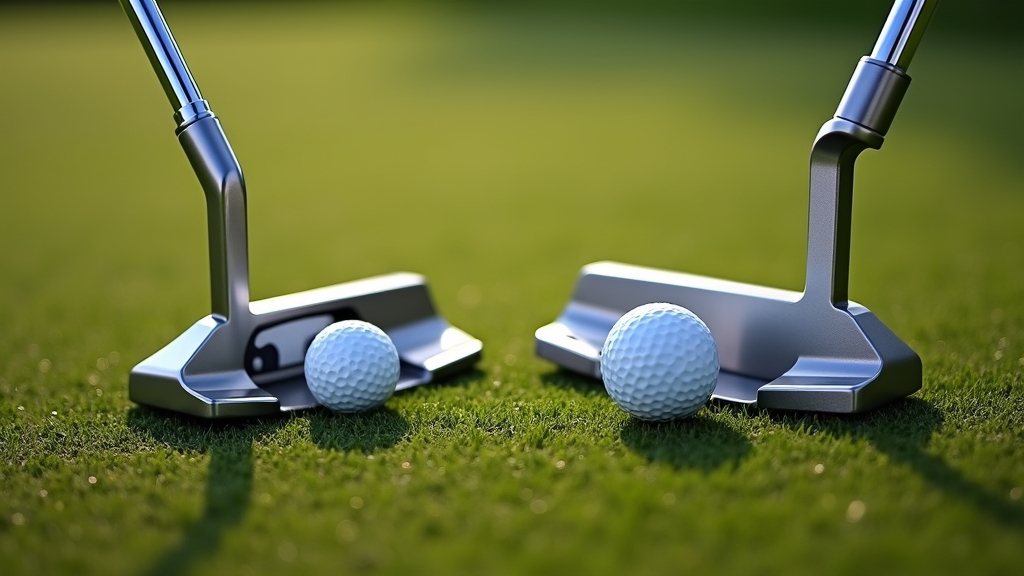
Since forgiveness directly affects how well a putter handles off-center strikes, understanding its differences between blade and mallet designs is essential for optimizing your performance.
Mallet putters excel here, featuring larger heads with higher MOI and perimeter weighting that stabilize the clubhead on mishits. This design minimizes ball speed and directional loss, thanks to a bigger sweet spot and enhanced weight distribution.
For example, the Bettinardi INOVAI 6.5 Putter uses a unique fang design and optimized Moment of Inertia (high MOI) to minimize twist during mishits, ensuring consistent roll. In addition, mallet putters can help reduce hand cramping by providing more stability during extended play.
Blade putters, in contrast, have smaller heads and a centralized center of gravity, resulting in a reduced sweet spot and more sensitivity to off-center strikes. While blades offer superior feedback aiding skilled players, they demand more consistent contact.
Blades deliver enhanced feedback but require precise, consistent contact for optimal performance.
Playability-wise, mallets’ alignment aids and stability facilitate repeatable setup and strokes, making them easier for average golfers. Blades favor precision and feel but require refined technique to maintain consistent results.
Compatibility With Different Stroke Types
Understanding how a putter interacts with your stroke type can considerably impact your consistency and control on the greens.
If you have a straight-back, straight-through stroke, mallet putters with face-balanced designs suit you best. They promote stability and minimize face rotation thanks to their perimeter weighting and higher MOI. In fact, 62% of the top 50 players in 2022 preferred mallet putters for these reasons. These putters also help maintain a steady pace by promoting smoother stroke mechanics.
Conversely, if your stroke incorporates an arc, a blade putter with toe hang complements your natural clubface rotation. This allows for more precise manipulation and feedback.
Blades’ concentrated weight near the face supports this arc-style motion but offers less forgiveness.
Additionally, mallet putters feature bold alignment aids that reinforce a straight stroke visually.
Blades provide minimal alignment cues, appealing to players relying on feel.
Choosing between blade and mallet hinges on matching the putter’s weight distribution and balance to your stroke mechanics for ideal performance.
Distance Performance and Player Preferences
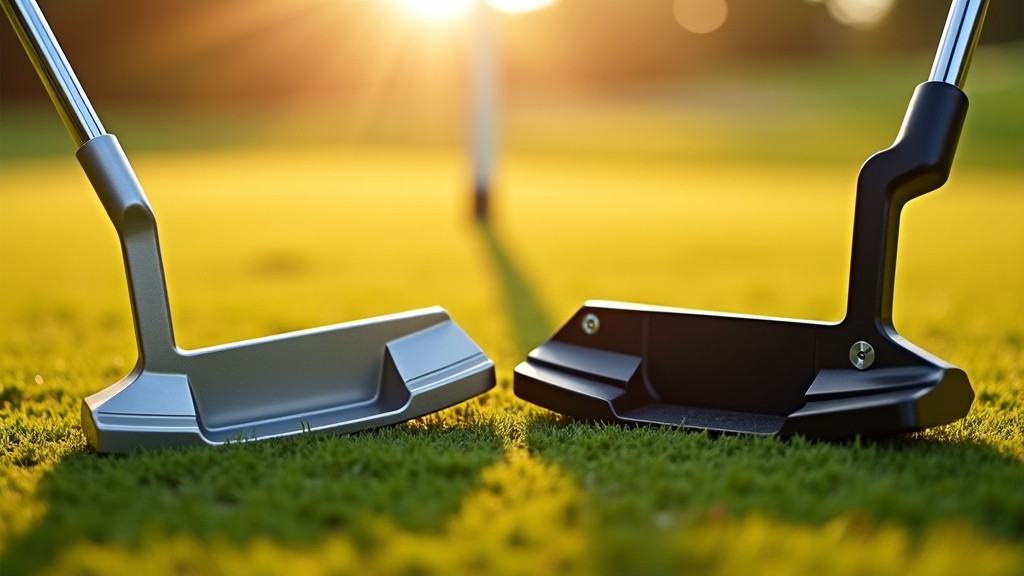
Although mallet putters excel in short-range putting with an 82% make rate inside 6 feet, blades outperform them at mid to long distances, particularly beyond 10 feet.
Mallets reduce 3-putts to 2.3 per round, thanks to superior distance control and forgiveness via larger sweet spots and alignment aids. This statistical advantage is reflected in the fact that mallet putters have a lower overall 3-putt frequency compared to blades.
Blades, however, provide better lag proximity (7.3 ft vs. 7.7 ft) and higher make percentages from 10 and 20 feet, favored by players emphasizing touch and feel. Recreational golfers lean toward mallets for their short-range consistency, while tour pros show a 77% preference for mallets or mid-mallets.
Ultimately, your choice should match stroke type and fit, as improper fitting—common in 80% of golfers—negatively impacts distance performance despite the putter’s inherent strengths.
Frequently Asked Questions
How Does Putter Choice Affect Green Reading and Reading Breaks?
Your putter choice directly influences how you read greens and breaks. Mallets, with their larger heads and alignment aids, help you visualize breaks more easily and promote a straight stroke. This stabilizes your line.
Blades demand sharper feel and precise reads due to their minimal design and arc stroke compatibility. If you want more forgiveness and easier break reading, mallets assist you. Blades, on the other hand, require refined touch and aggressive green reading skills.
Are There Differences in Maintenance Between Blade and Mallet Putters?
Yes, maintenance differs between blade and mallet putters. You’ll find blades easier to clean due to their simpler, smoother design with fewer crevices, allowing quick wiping and polishing.
Mallets’ complex shapes and multi-material heads need more thorough cleaning, often requiring brushes for alignment lines and care to avoid damaging coatings.
Both need regular inspection and cleaning, but mallets may demand extra attention to protect paint, coatings, and adjustable components.
What Impact Does Putter Shaft Length Have on Blade Vs Mallet Performance?
You’ll notice shaft length affects blade and mallet putters differently. Longer shafts on blades increase arc radius and face rotation, amplifying toe hang effects, which demands precise control.
For mallets, shaft length changes impact face rotation less due to their face-balanced design, promoting stability and a straighter stroke.
Adjusting shaft length helps you optimize posture and stroke mechanics.
Shorter shafts boost control in blades, while mallets benefit from lengths that maintain square face alignment.
Can Blade or Mallet Putters Be More Effective on Different Green Speeds?
Imagine your putter as a key revealing green speed secrets. On fast greens, blade putters offer precision and delicate control. They let you finesse speed and direction with their smaller sweet spots.
On slower greens, mallets shine with heavier heads and higher forgiveness. They power putts through rougher surfaces and aid alignment.
How Do Blade and Mallet Putters Differ in Terms of Resale Value?
You’ll find blade putters generally hold higher resale values, especially iconic models like Scotty Cameron Newport 2 or Ping Anser, thanks to their classic status and tour validation. Mallet putters tend to depreciate faster and rarely appreciate markedly. Brand reputation, model rarity, and condition heavily influence this.
Limited-edition or tour-proven blades can even exceed original prices, while mallets, despite advanced features, usually don’t match blades’ long-term market strength.
Elevate Your Putting Game with the Right Choice
When choosing between blade and mallet putters, consider how weight distribution affects your stroke. While blade putters offer precision with a smaller moment of inertia, mallets provide greater forgiveness, especially on off-center hits.
If you have a straight-back-straight-through stroke, a mallet might boost consistency. But if you prefer a slight arc, a blade could enhance feel. Understanding these subtle differences helps you match your technique with the putter that truly elevates your game.
- TOUR DESIGN: Classically designed blade style putter with premium milled alloy face for maximum…
- GREAT VALUE: must-have for golfers who want the look and feel of a a tour putter without breaking…
- PREMIUM COMFORT GRIP: Features a textured anti-slip pistol grip with a premium comfort and feel on…
- EXTREME FORGIVENESS – The Orlimar F80 is a high MOI mallet putter with additional rear heel and toe…
- SOFT FACE INSERT – Provides a consistent roll, added feel and a muted sound at impact.
- WELL BALANCED PUTTER DESIGN – The double-bend shaft creates an offset for the proper hand position…
Last update on 2025-12-11 / Affiliate links / Images from Amazon Product Advertising API
